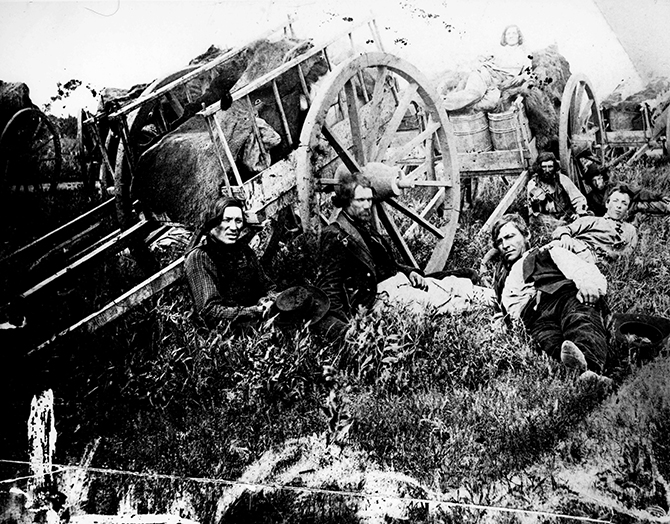clay county histories

Métis teamsters taking a break along the Red River Trails
Markus Krueger | Program Director HCSCC
The new Clay County history exhibit will be opening on September 10. The exhibit explores the time period 150 years ago when widespread US settlement of Clay County began, including the founding of Glyndon, Hawley, Moorhead and our county government. But for the first time, our local origin story includes Indigenous perspectives. Who called this place home in 1850? And where were they in 1880? What happened?
Those are big questions, and when we started researching for this exhibit three years ago, we found that no book adequately covered it. We at the Historical and Cultural Society of Clay County know the traditional founding story like the backs of our hands – the railroad arrives in 1871, bringing a flood of farmers and creating towns to service them. We know all about the Homestead Act and Amerika Trunks and the Hudson’s Bay Company fur trading station at Old Georgetown. But what should be said about the Dakota, Ojibwe, and Métis people who already lived here? Most tellers of this tale over the past 150 years acted as if they just disappeared in 1871.
We needed help finding these stories. Thanks to the Minnesota Historical Society, we assembled a team of regional Indigenous scholars to guide our research and writing. Gwen Westerman literally wrote the book on the Dakota people in Minnesota – Mni Sota Makoce: The Land of the Dakota. Kade Ferris is the Tribal Historic Preservation Officer for the Red Lake Nation and publisher of the Dibaajimowin.com website. Liselotte Erdrich’s family is everywhere in the story we are telling – her ancestors were among the founders of the Pembina Ojibwe, signors of the Old Crossing Treaty in 1863, present at the historic 1870 Treaty of Fort Abercrombie between the Dakota and Ojibwe nations, and if you want to learn about how her Grandpa Pat Gourneau helped save the Turtle Mountain Chippewa Tribe from termination in the 1950s, her sister Louise just won the Pulitzer Prize for her book The Night Watchman about it. And Dakota elder Glenn Wasicuna, who has a quiet demeanor but whenever he speaks you can hear a pin drop because it’s probably going to be incredibly wise and likely pretty funny, too.
The title for the exhibit was given to us by Glenn Wasicuna: “Makoce kin ihdago manipi” – “They leave marks as they come through here.” So many have left their marks here – pioneers like Randolph Probstfield and Berit Hitterdal, and pioneers of different sorts like Professor Yvonne Condell and rock n’ roller Bob Becker. Sisseton chief Standing Buffalo left his mark, and so did a kid at Holy Cross named Mooshum. You and I do, too.
This exhibit is officially about the Sesquicentennial of the founding of Clay County, but it is really about the dramatic change in this land and its people between 1850-1880. It’s a story of treaties and wars, transcontinental railroads and Red River Trails, tallgrass prairie and family farms, and people making their way through the biggest period of change in the history of this land.

